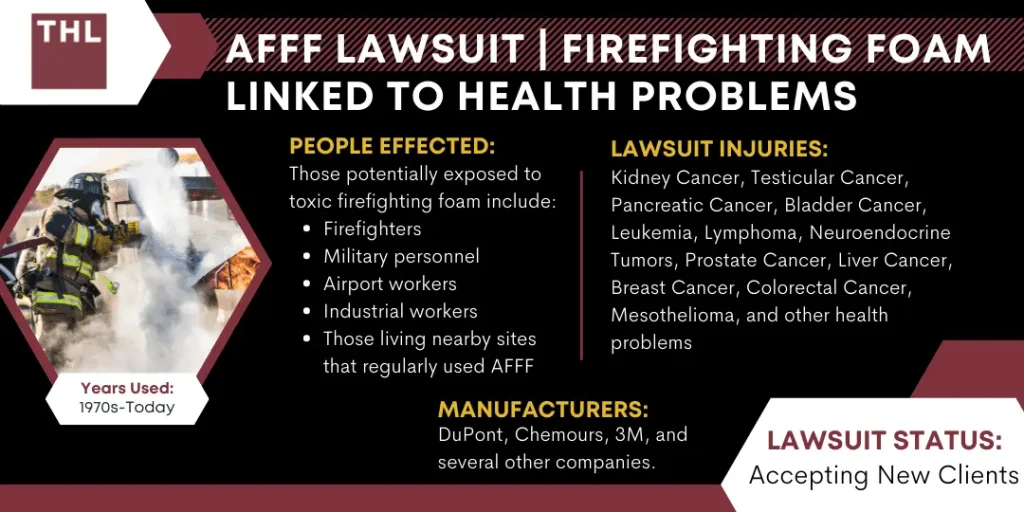AFFF Lawsuit Update, Massive Settlements Looming as 15,000+ Cases Expose Decades of Corporate Deception
The AFFF lawsuit involves over 15,000 personal injury claims against manufacturers like 3M, DuPont, and Chemours who produced firefighting foam containing toxic PFAS “forever chemicals” linked to cancer and other serious diseases. Recent developments include postponed bellwether trials, a September 5, 2025 filing deadline that triggered over 37,000 new case submissions, and ongoing settlement negotiations that legal experts predict could conclude by early 2026. Current and former firefighters, military personnel, and residents near contaminated sites who developed kidney cancer, testicular cancer, thyroid disease, ulcerative colitis, liver cancer, or thyroid cancer can pursue legal action.
What Is the AFFF Lawsuit and Who Are the Plaintiffs?
Plaintiffs in the AFFF multidistrict litigation (MDL 2873) are primarily current and former civilian and military firefighters who claim that manufacturers including 3M, DuPont, Chemours, BASF, Tyco Fire Products, and over 50 other companies knowingly sold firefighting foam laced with PFAS chemicals despite decades of internal evidence showing health risks.
The lawsuit alleges these companies were aware for decades that PFAS exposure increases cancer risk and causes chronic conditions, yet they failed to warn users or withdraw products from the market, continuing to manufacture and promote AFFF even after internal studies and regulatory pressure revealed harmful effects.
The federal litigation is centralized in the District of South Carolina under Judge Richard Gergel, with nearly 10,000 personal injury lawsuits pending, many originating from communities near military bases in Horsham and Warminster, Pennsylvania, where PFAS contamination in drinking water has been documented.
Damning Evidence: What Manufacturers Knew and When
Internal company documents released through Minnesota’s lawsuit against 3M revealed that the manufacturer knew by the 1970s that PFOA and PFOS were toxic and accumulating in people’s blood, with company meeting minutes from 1978 stating these chemicals “should be regarded as toxic”.
By the early 1960s, 3M knew PFAS chemicals didn’t degrade in the environment, and by 1976, the company discovered these chemicals were in plant workers’ blood at higher levels than normal. A 1978 study of rhesus monkeys exposed to PFAS had to be aborted after 20 days because all exposed monkeys died.
Despite evidence dating back to 1949 showing PFAS did not degrade, 3M continued marketing its firefighting foams as “environmentally neutral” and “biodegradable” from 1979 through the early 1990s. These misleading claims encouraged widespread disposal practices including releasing foam effluent into rivers and applying contaminated sludge to agricultural fields.
By the 1990s, 3M and DuPont discovered increased cancer rates among PFAS workers but kept studies secret from employees and the public for decades.
Recent Legal Developments Accelerating Settlement Timeline
The most significant recent development occurred in October 2025, when 1,307 new cases were added to the MDL in a single month—one of the largest monthly increases in the litigation’s history—bringing the total to 15,249 pending cases.
Judge Gergel postponed the first bellwether trial originally scheduled for October 20, 2025, and created a 21-day “Filing Facilitation Window” ending September 5, 2025, requiring all personal injury cases involving six core conditions to be filed during this period. This deadline triggered an unprecedented surge, with more than 37,000 new lawsuits filed, more than tripling the MDL’s size.
Expert discovery continues with plaintiffs’ expert reports already submitted, and defendants’ reports due October 24, 2025, with plaintiffs’ rebuttal reports due November 21, 2025.
The court held Science Days in June 2025, where experts presented evidence linking PFAS exposure to various cancers, with a second session on June 20, 2025, focusing on thyroid cancer and liver cancer.

Specific Claims Plaintiffs Have Made Against Manufacturers
Plaintiffs claim they used AFFF products as intended during firefighting and training activities but were never informed of the risks, nor were they provided with protective measures to guard against PFAS exposure. They assert that manufacturers continued to promote AFFF and turnout gear containing PFAS even after internal studies revealed harmful effects.
The lawsuits advance multiple legal theories:
Product Liability Claims: Manufacturers designed, produced, and distributed defective products containing dangerous PFAS chemicals without adequate warnings.
Negligence: Companies failed to exercise reasonable care by concealing known health risks from users and regulatory agencies.
Failure to Warn: Defendants neglected to provide adequate warnings about cancer risks and proper safety measures for AFFF handling.
Fraudulent Concealment: Manufacturers allegedly suppressed evidence of PFAS toxicity and continued marketing products as safe despite contradictory internal research.
What Cancers and Conditions Qualify for Legal Action?
The court has identified six core conditions eligible for inclusion in the MDL: kidney cancer, testicular cancer, liver cancer, thyroid cancer, thyroid disease, and ulcerative colitis.
Recent scientific research strengthens these claims, with a study in Environmental Research finding that firefighters exposed to PFAS had significant changes in microRNAs that regulate genes involved in cancer suppression and immune system function. The study linked PFAS exposure to changes associated with kidney, liver, bladder, and blood cancers, as well as neurodegenerative and autoimmune diseases.
Judge Gergel ruled that the first bellwether trials will focus on kidney cancer, which attorneys believe represents one of the strongest claims.
Massive Settlements Already Reached in Water Contamination Cases
In June 2023, 3M agreed to a historic $10.3 billion settlement to resolve PFAS contamination claims in public water systems across the United States, to be paid over 13 years. In 2024, a judge approved a $1.185 billion settlement from DuPont, Chemours, and Corteva to address PFAS-related drinking water claims.
In May 2025, 3M agreed to pay New Jersey up to $450 million for PFAS water contamination, to be distributed over 25 years. In October 2024, Carrier Global reached a $730 million settlement to resolve claims against their subsidiary Kidde-Fenwal.
In 2021, Tyco Fire Products, Chemguard, and ChemDesign reached a $17.5 million settlement with Wisconsin residents, with $2.5 million designated for individuals diagnosed with testicular cancer, kidney cancer, thyroid disease, and ulcerative colitis—the first U.S. settlement addressing personal injuries from PFAS exposure.
Projected Settlement Amounts for Personal Injury Cases
While no global personal injury settlement has been finalized, legal experts project tiered compensation structures based on case strength.
Tier 1 Cases (strongest claims): Projected settlements of $200,000 to $500,000 or more for plaintiffs with clear AFFF exposure history, diagnosed qualifying cancers, minimal confounding factors, and substantial medical documentation.
Tier 2 Cases (moderate claims): Estimated settlements of $100,000 to $200,000 for plaintiffs with documented exposure and qualifying diagnoses but some complicating factors.
Tier 3 Cases (weaker claims): Projected settlements of $75,000 or less for cases with less conclusive links between exposure and diagnosis.
Settlement amounts depend on factors including exposure duration and intensity, cancer type and severity, medical expenses and treatment costs, lost wages and earning capacity, and documentation quality.
Legal experts believe defendants will settle most lawsuits before trial, following the same pattern as water contamination cases they settled for billions, as the AFFF lawsuits present strong cases with mounting scientific evidence.
Statute of Limitations: Critical Timing Information
Most states have statutes of limitations of two to three years for personal injury lawsuits, but almost every state follows a discovery rule that extends these deadlines in toxic exposure cases. Under the discovery rule, the clock doesn’t start until the plaintiff knows, or reasonably should have known, that they suffered an injury connected to AFFF exposure—often only years after exposure when a cancer diagnosis is made.
Some states have separate statutes for toxic torts, fraud, or concealment that can further extend filing deadlines when defendants withheld critical safety information from the public.
The September 5, 2025, filing deadline represented a critical court-imposed window, though plaintiffs can still explore additional legal options outside the MDL structure. With an anticipated global settlement potentially approaching, statute of limitations concerns and settlement cutoffs could permanently bar new claims.
Who Can File an AFFF Lawsuit?
Individuals may qualify if they were exposed to AFFF on the job and later diagnosed with a PFAS-related cancer. Eligible plaintiffs include:
Military Firefighters: Service members who worked as military firefighters at bases and shipyards where the Navy required AFFF on board vessels and at installations.
Airport Firefighters: Aviation facility personnel who used AFFF extensively in fire suppression systems and were frequently exposed during training exercises and emergency responses.
Municipal Firefighters: Career and volunteer firefighters who trained with or used AFFF in fire departments.
Military Personnel and Residents: Veterans and military families who lived near bases or airports and consumed PFAS-contaminated drinking water.
Civilian Workers: Industrial plant workers, oil rig personnel, and others with occupational AFFF exposure.
Family members or estate representatives can file wrongful death lawsuits on behalf of deceased loved ones who died from PFAS-related cancers, potentially recovering compensation for medical expenses, funeral costs, lost financial support, and loss of companionship.
Steps to Pursue Legal Action
1. Document Your Exposure History: Gather employment records, training documentation, military service records, duty station assignments, and evidence of proximity to contaminated sites.
2. Obtain Medical Records: Collect cancer diagnosis documentation, treatment records, pathology reports, and physician statements linking illness to AFFF exposure.
3. Consult an Experienced AFFF Attorney: Contact law firms handling AFFF litigation who can evaluate your case at no cost and explain qualification criteria.
4. File Before Deadlines Expire: Act promptly to avoid missing state-specific statutes of limitations or court-imposed filing windows.
5. Participate in Discovery: Work with attorneys to provide testimony, medical examinations, and documentation during the legal process.
Most AFFF attorneys work on contingency, meaning no upfront costs—they only collect fees if you receive compensation.

Current Status and What Happens Next
Legal experts predict defendants will reach a global settlement in 2025 or early 2026 before bellwether trials, as judges and special masters push parties toward resolution. At recent status conferences, Judge Gergel has pressed 3M, DuPont, BASF, Johnson Controls, and other defendants to settle personal injury claims quickly.
Parties are working with a court-appointed special master on developing a “settlement matrix”—a points-based system for valuing claims that could facilitate a global resolution covering thousands of plaintiffs.
If settlement negotiations fail, the first bellwether trials will establish precedents for evidence, expert testimonies, and legal facts that could influence thousands of remaining cases.
Link to Official Resources
For the latest court updates, visit the District of South Carolina AFFF MDL page.
For PFAS health information, consult the EPA’s PFAS Resources and ATSDR PFAS Health Effects.
Frequently Asked Questions About the AFFF Lawsuit
Q: What exactly is the AFFF lawsuit about?
A: The AFFF lawsuit is a massive multidistrict litigation (MDL 2873) consolidating over 15,000 federal cases against manufacturers of aqueous film-forming foam containing toxic PFAS chemicals linked to cancer and serious health conditions. Plaintiffs allege companies like 3M, DuPont, Tyco Fire Products, and others knowingly manufactured and sold dangerous firefighting foam while concealing serious health risks from firefighters, military personnel, and communities.
Q: What recent legal developments have occurred in the AFFF lawsuit?
A: Recent developments include the addition of 1,307 new cases in October 2025 alone, bringing the total to 15,249 pending cases, postponement of the first bellwether trial originally scheduled for October 20, 2025, and ongoing expert discovery with defendants’ expert reports due October 24, 2025. A court-imposed September 5, 2025 filing deadline triggered over 37,000 new lawsuit submissions.
Q: What evidence exists that manufacturers knew about PFAS dangers?
A: Internal 3M documents revealed the company knew by the 1970s that PFOA and PFOS were toxic and accumulating in people’s blood, with 1978 company meeting minutes stating these chemicals “should be regarded as toxic”. A 1978 study of rhesus monkeys exposed to PFAS had to be aborted after 20 days because all exposed monkeys died. Despite evidence from 1949 showing PFAS did not degrade, 3M marketed firefighting foams as “environmentally neutral” and “biodegradable” through the early 1990s.
Q: What types of cancer and illnesses qualify for AFFF lawsuits?
A: The court has identified six core conditions eligible for the MDL: kidney cancer, testicular cancer, liver cancer, thyroid cancer, thyroid disease, and ulcerative colitis. Plaintiffs diagnosed with these conditions after AFFF exposure during firefighting activities or from contaminated drinking water near military bases can pursue legal action.
Q: How much compensation can AFFF lawsuit plaintiffs expect to receive?
A: While no global personal injury settlement has been finalized, projected settlements range from $75,000 for weaker claims to $200,000-$500,000 or more for the strongest cases. The first personal injury settlement in 2021 awarded $2.5 million to Wisconsin residents with testicular cancer, kidney cancer, thyroid disease, and ulcerative colitis. In water contamination cases, 3M paid $10.3 billion, DuPont paid $1.185 billion, and Carrier Global paid $730 million.
Q: What is the statute of limitations for filing an AFFF lawsuit?
A: Most states have statutes of limitations of two to three years, but almost every state follows a discovery rule that extends these deadlines in toxic exposure cases, starting the clock when the plaintiff knows or should have known their injury was connected to AFFF exposure. Some states have separate statutes for toxic torts, fraud, or concealment that further extend filing deadlines when defendants withheld critical safety information.
Q: How do I know if I qualify to file an AFFF lawsuit?
A: You may qualify if you were exposed to AFFF on the job and later diagnosed with a PFAS-related cancer. Eligible individuals include military firefighters who served at bases and shipyards, airport firefighters at aviation facilities, municipal career and volunteer firefighters, military personnel and residents near contaminated bases who drank contaminated water, and civilian workers with occupational AFFF exposure.
Disclaimer: This information is for educational purposes only and does not constitute legal advice. If you believe you have been affected by AFFF contamination, consult with a qualified attorney to discuss your specific situation and legal options. The outcomes described are based on current litigation developments and do not guarantee future results.
About the Author

Sarah Klein, JD, is a licensed attorney and legal content strategist with over 12 years of experience across civil, criminal, family, and regulatory law. At All About Lawyer, she covers a wide range of legal topics — from high-profile lawsuits and courtroom stories to state traffic laws and everyday legal questions — all with a focus on accuracy, clarity, and public understanding.
Her writing blends real legal insight with plain-English explanations, helping readers stay informed and legally aware.
Read more about Sarah
